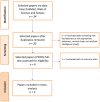Diagnostic Accuracy of Machine-Learning Models on Predicting Chemo-Brain in Breast Cancer Survivors Previously Treated with Chemotherapy: A Meta-Analysis
- PMID: 36554712
- PMCID: PMC9779296
- DOI: 10.3390/ijerph192416832
Diagnostic Accuracy of Machine-Learning Models on Predicting Chemo-Brain in Breast Cancer Survivors Previously Treated with Chemotherapy: A Meta-Analysis
Abstract
We performed a meta-analysis of chemo-brain diagnostic, pooling sensitivities, and specificities in order to assess the accuracy of a machine-learning (ML) algorithm in breast cancer survivors previously treated with chemotherapy. We searched PubMed, Web of Science, and Scopus for eligible articles before 30 September 2022. We identified three eligible studies from which we extracted seven ML algorithms. For our data, the χ2 tests demonstrated the homogeneity of the sensitivity's models (χ2 = 7.6987, df = 6, p-value = 0.261) and the specificities of the ML models (χ2 = 3.0151, df = 6, p-value = 0.807). The pooled area under the curve (AUC) for the overall ML models in this study was 0.914 (95%CI: 0.891-0.939) and partial AUC (restricted to observed false positive rates and normalized) was 0.844 (95%CI: 0.80-0.889). Additionally, the pooled sensitivity and pooled specificity values were 0.81 (95% CI: 0.75-0.86) and 0.82 (95% CI: 0.76-0.86), respectively. From all included ML models, support vector machine demonstrated the best test performance. ML models represent a promising, reliable modality for chemo-brain prediction in breast cancer survivors previously treated with chemotherapy, demonstrating high accuracy.
Keywords: breast cancer; chemo-brain; chemotherapy; diagnostic accuracy; machine learning.
Conflict of interest statement
The authors declare no conflict of interest. The funders had no role in the design of the study; in the collection, analyses, or interpretation of data; in the writing of the manuscript; or in the decision to publish the results.
Figures






References
-
- Argyriou A.A., Assimakopoulos K., Iconomou G., Giannakopoulou F., Kalofonos H.P. Either Called “Chemobrain” or “Chemofog”, the Long-Term Chemotherapy-Induced Cognitive Decline in Cancer Survivors Is Real. J. Pain Symptom. Manag. 2011;41:126–139. doi: 10.1016/j.jpainsymman.2010.04.021. - DOI - PubMed
Publication types
MeSH terms
LinkOut - more resources
Full Text Sources
Medical
Miscellaneous

